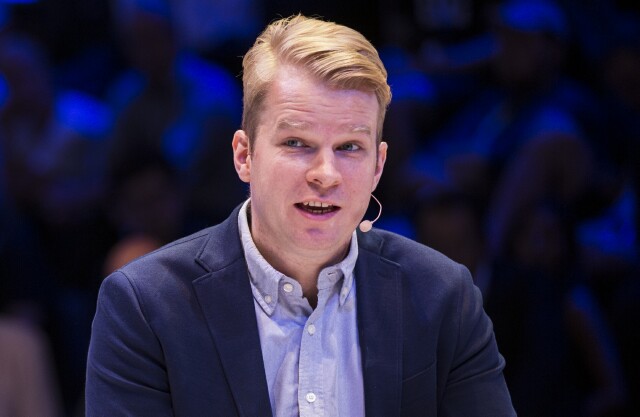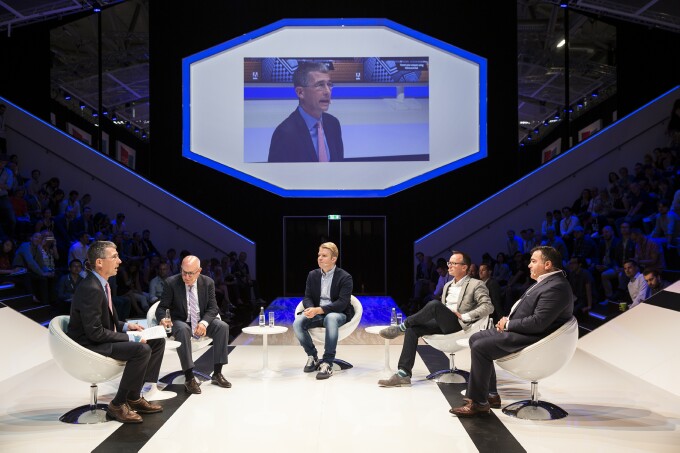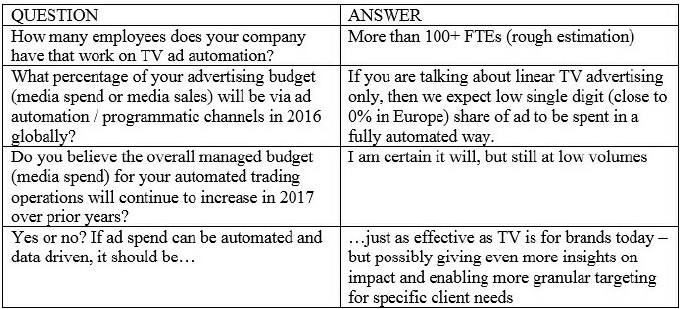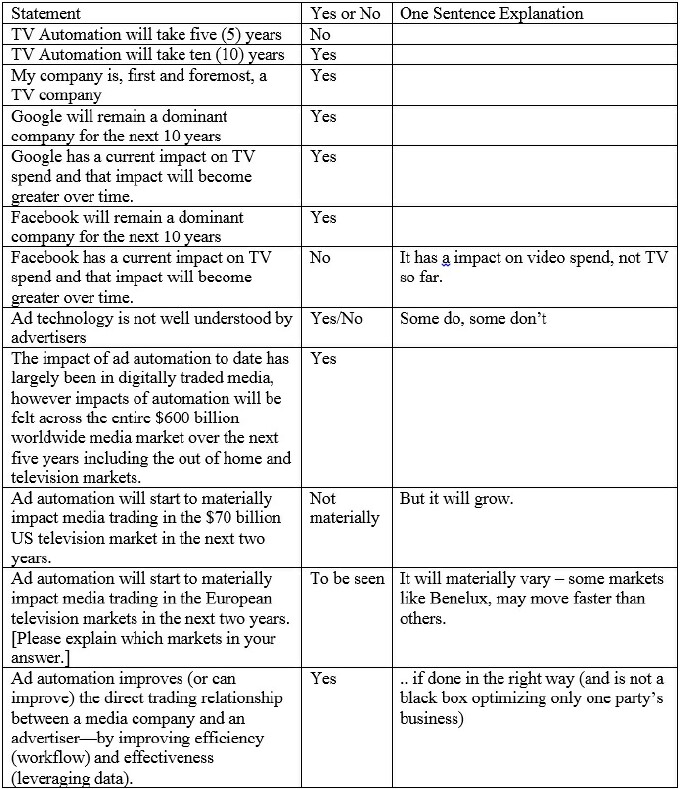Rhys Noelke of RTL on TV and Ad Automation

Jay Sears, Senior Vice President of Marketplace Development at Rubicon Project recently spoke with Rhys Noelke, Senior Vice President Strategy at RTL about TV and ad automation. The two appeared at a program on the topic at Dmexco in Cologne, Germany in September. You can view a video of the program below.

(TV and ad automation was discussed at the Dmexco conference in Cologne, Germany in front of an audience of nearly one thousand people. Pictured left to right: Jay Sears; Michael Kahn, CEO of Performics and Global Performance Practice Lead -- Publicis Media; Rhys Nölke; Jamie West, Deputy Managing Director of Sky Media, and Michael Strober, Executive Vice President, Client Strategy and Ad Innovation and Co-Head of Turner Ignite at Turner Broadcasting. Follow the links above to read Jay’s interviews with them.)
JAY SEARS: What do you read to keep up with politics, art and culture?
RHYS NOELKE: Der Spiegel, Wall Street Journal and Sueddeutsche Zeitung
SEARS: What do you read to keep up with friends?
NOELKE: Facebook, Instagram, WhatsApp
SEARS: What do you read to keep up with the advertising, technology and TV industries?
NOELKE: Adweek, Variety, Video Ad News, Adexchanger
SEARS: What’s your favorite TV commercial of all time?
NOELKE: Actually it is an online campaign that went viral sometime in 2005/6 and was then shown also on TV in Germany (for caffeinated beverage K-fee). The best TV campaign is P&G’s Old Spice campaign. It just tells you an imaginative story for a product that you had already forgotten about. Both show you how simple a great TV or video spot can be.
SEARS: When you speak about TV ad automation, how widely or narrowly do you define this?
NOELKE: I think a clear distinction would be helpful, but I’m afraid it will continue to be used in multiple ways. In my view the distinction should be made, if linear TV ad breaks are loaded in a fully automated way (from actual sale to actual insertion of a TV spot into linear), then we should talk about TV automation. All other kinds of OTT linear or CTV and mobile video insertions only cover parts of the sales process. Agencies already upload their creatives digitally, but companies like Clypd -- in which RTL Group has invested -- actually allow the planning and booking process [to be] uniquely automated and data driven, while the ad insertion may still be handled or greenlighted manually by most broadcasters. So in fact there is still some way to go until we can really say that TV sales are automated.
SEARS: With regards to advertising automation impacting TV, what are the three biggest trends you expect to impact companies in 2016 and 2017?
NOELKE:
- Programmatic: The confusion around programmatic TV definitions and standards
- Data: The aggregation, matching and harmonization of data sources
- Measurement: The alignment of the industry around cross-platform audience measurement
SEARS: With regards to advertising automation impacting TV, what are the three most overblown topics that you wish would just go away?
NOELKE:
- Video Look-a-Likes: All kinds of video ad formats, that are not related to true video content (but rather rich media/display)
- Models: Cost-per-view models or skippable ads
- Silos: Island solutions or individualized standards (also walled gardens)
SEARS: Describe your company or division and then tell us the top three opportunities you are working on to advance TV automation.
NOELKE: RTL Group is a leader across broadcast, content and digital, with interests in 60 television channels and 31 radio stations, content production throughout the world and rapidly growing digital video businesses. For us, TV isn’t just “television” anymore, it means “Total Video.” This is important as many people still think that TV is just for the living room, ignoring the multitude of platforms and devices that we reach already today. That’s why video is at the heart of our digital strategy as we focus in content creation at FremantleMedia, aggregation via multi-channel networks like Broadband TV, Stylehaul and Divimove, as well as tech-driven advertising capabilities with investments in SpotX, Smartclip, Clypd and Videoamp.
Programmatic TV and automated TV sales are still nascent and it will take considerable time for the infrastructure to scale and become a relevant part of the business. It is our goal to be at the forefront of the transforming TV landscape and pioneer more efficiency driven sales models. At the moment, this takes the form of various pilots we are working on internally and with external partners to develop use cases and prioritize opportunities.

SEARS: The majority of ad technology and TV technology companies have struggled (relatively small, unprofitable or both). Of the poor performers, what are the commonalities between them that have contributed to this weakness?
NOELKE: This is an evolutionary process; so many companies have been struggling because it’s a marathon run for years to come and not just a hockey stick business model set out for three or five years. Technically some advancement has been made, but the issue is that most are “island solutions” and the market coverage remains fairly niche. Alignment and standardization throughout the TV value chain will be essential.
SEARS: With respect to TV automation, there seem to be three camps: partnering with scaled digital first automation companies that are now moving into TV, partnering with start-up “TV first” automation companies, and companies that choose to build a solution themselves without a partner. What do you see as the strength and weakness of each approach, and what do you believe is the best mix for your company?
NOELKE: It will be a mix of all three. Experimental innovation needs to paired with market experience. Growth will also rely on successfully integrating offers into an end-to-end solution.
SEARS: A smaller handful of ad technology and TV technology companies has achieved scale and performed better than the rest. What are the commonalities between them that have contributed to this relative strength?
NOELKE: I think success in this space is relative. Some players are heavily backed by the investors but lack inventory or technology, others may have strong technical capabilities but lack the support either from the demand, distribution or supply side.
SEARS: Do we live in a “tale of two cities” where Google and Facebook win almost everything, advertisers are dictated to and other media companies fight for the scraps? Do you believe this is the case in digital or not? And what do you expect the impact of Google and Facebook to be in TV?
NOELKE: I personally believe that even online giants are also struggling to replicate the TV model as such. Taking a clear role in the demand/supply value chain side is tricky if you control the platform and distribution as well. I think there is enough room for independent players to make their cut.
SEARS: How can advertising automation help the strategy and planning functions (directly or indirectly) at an advertising agency?
NOELKE: Generally, booking and reporting tools are still very siloed and it would be advantageous to set a golden standard. This would also help coordinate and optimize cross-platform campaigns.
SEARS: Transparency -- on media costs, on data, on inventory -- continues to be a lightning rod issue. Should transparency be a negotiated benefit for the advertiser client, yes or no?
NOELKE:If transparency adds value for the advertiser client (which we believe when it comes to data for example), then it should have a price.
SEARS: Please answer the following statements yes or no.
NOELKE:

(Video above: TV and ad automation was discussed at the Dmexco conference in Cologne Germany in front of an audience of nearly one thousand people.)
SEARS: If you had your own TV talk show, what would you name it?
NOELKE: The BlaBla Show (Is this a serious question?)
SEARS: A young family member has come to you seeking career advice. They must choose one of the following careers: ad agency executive, media company executive, ad technology executive or company marketing executive. Which career path do you recommend and why?
NOELKE: Media executive … you can still to do all the other ones after.
SEARS: What is your favorite restaurant in the world?
NOELKE: Le Moissonnier in Cologne -- one of the best restaurants in one of the best cities in Germany.
SEARS: Thanks, Rhys!
The opinions and points of view expressed in this commentary are exclusively the views of the author and do not necessarily represent the views of MediaVillage.com/MyersBizNet, Inc. management or associated bloggers.


